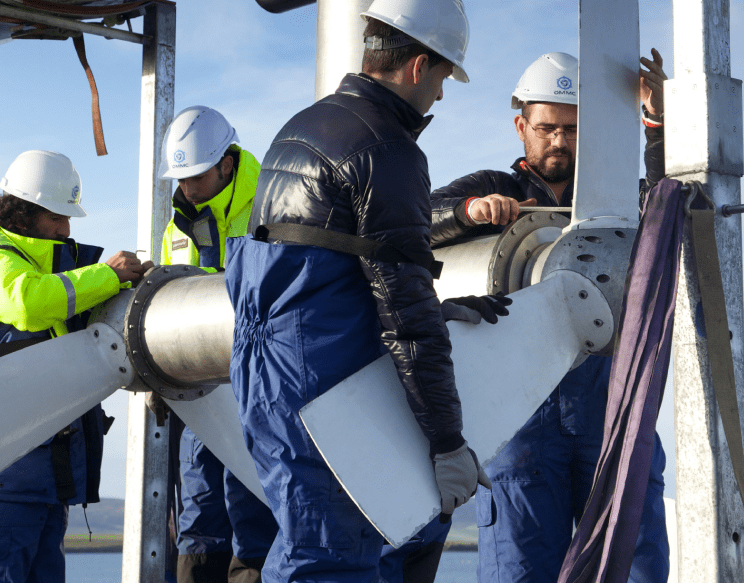Construction, Operations
and Maintenance
Background
The construction and subsequent operation of large, commercial-scale floating offshore wind farms presents a range of new challenges and considerations compared to fixed-foundation offshore wind projects. The marshalling, assembly, and integration of large numbers of floating turbines will drive new port requirements, and installation will require new vessels and procedures not used in existing fixed-foundation projects. Once installed, floating turbines will be required to operate in different site environments compared to fixed-foundation projects and new components will drive different operations and maintenance requirements.
In order for the offshore wind industry to scale up the construction of FOW farms and to reduce the costs for operating and maintaining these large farms in the years ahead, there is a need to better understand these activities for floating wind and to develop new technologies and optimised methodologies in de-risking construction, operation and maintenance activities.
Photo Credit: Floatgen, Floating wind turbine equipped with the BW Ideol patented Damping Pool® foundation, operating in France since 2018 – Credits BW Ideol / V. Joncheray

Technical Challenges and Opportunities
The UK has already seen the successful construction and operation of several floating wind farms, however challenges and opportunities associated with gigawatt-scale projects still require further consideration. UK Port infrastructure needs to be upgraded and optimised in order to handle the significant amount of construction and servicing of FOW components expected to take place from 2030. Optimised installation methodologies and vessel requirements and demand must be understood, along with potential project risks at a commercial-scale. Whilst challenging, this presents considerable opportunities for long-term, strategic development of infrastructure.
While there is great experience that can be taken from fixed-foundation projects, the operations and maintenance of floating wind farms presents additional considerations, such as major component replacement in deep water, floating turbine motion, and new critical components such as mooring systems and dynamic cables. Although FOW O&M presents uncertainties, there are considerable opportunities in learning from other sectors, such as oil and gas, and developing new components, technologies and methodologies to address the new challenges involved.
Photo of the Kincardine Offshore Wind Farm project courtesy of Principle Power
UK Supply Chain Opportunity
Whilst meeting the demands of commercial-scale floating wind projects may be challenging, it also presents a great opportunity to the UK supply chain. Floating offshore wind construction can support port and supply chain development, and experience from parallel sectors such as fixed-foundation offshore wind and oil and gas provide valuable knowledge, experience and capability to support floating offshore wind.
However, to maximise these opportunities, it is important that the industry has a shared understanding of the construction and operational requirements of floating offshore wind farms.

What are we doing to help?
Through the Construction, Operations & Maintenance Strategic Programme, the Floating Offshore Wind Centre of Excellence is supporting offshore wind developers and the wider industry to understand the unique challenges and opportunities associated with commercial-scale floating offshore wind.
Photo of the WindFloat Atlantic project courtesy of Principle Power/Ocean Winds
The Floating Offshore Wind Centre of Excellence has recently completed projects on the following areas (summary reports to soon be made available):
- FOW Construction and O&M Model Benchmarking
- FOW Navigation Planning and Risk Assessment
In addition to this completed work, ongoing project areas include:
- FOW O&M Requirements and Cost Modelling
- Major Component Replacement Methodologies and Innovation Opportunities
- FOW Marshalling and Assembly in Restricted Ports
- Application of Remote and Autonomous Systems in FOW
- FOW Tow to Port Off-Station Management
In general, the strategic programme priorities are to:
- Reduce uncertainty in construction, operations and maintenance activities
- Increase supply chain capability, capacity and capability in key technology areas
- Close knowledge gaps through research
Through a combination of desk-based studies, state of the art modelling and simulation, and extensive industry stakeholder collaboration and engagement, the Construction, Operations and Maintenance Strategic Programme provides valuable insights into construction and O&M activities, and methodologies prior to commercial scale deployment of FOW. In turn, supporting the cost and risk reduction for deploying these technologies as part of the first large, commercial-scale floating offshore wind projects.
There aren’t currently any open application windows for opportunities associated with this Strategic Programme. Please check back in again soon.
Photo of the Kincardine Offshore Wind Farm project courtesy of Principle Power
Get in touch
